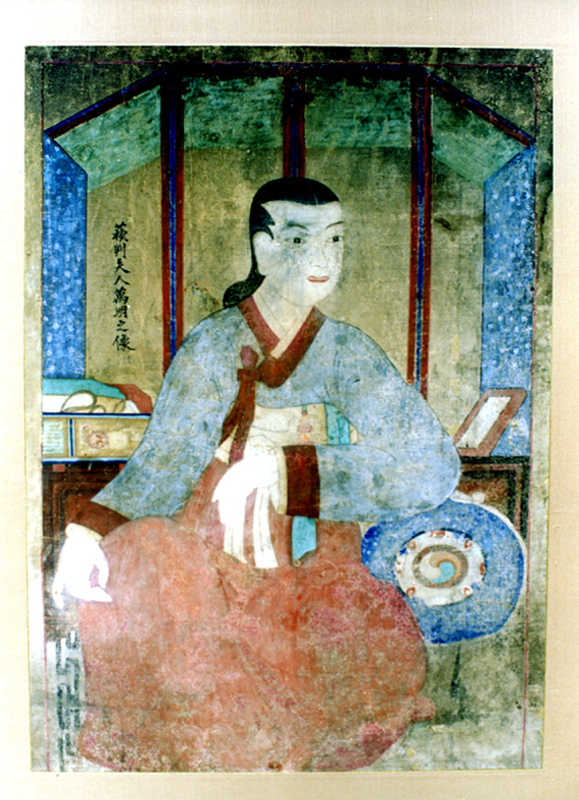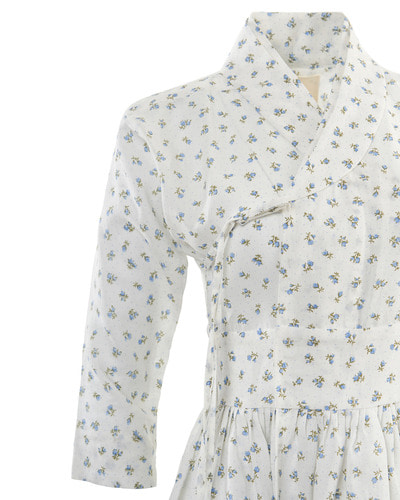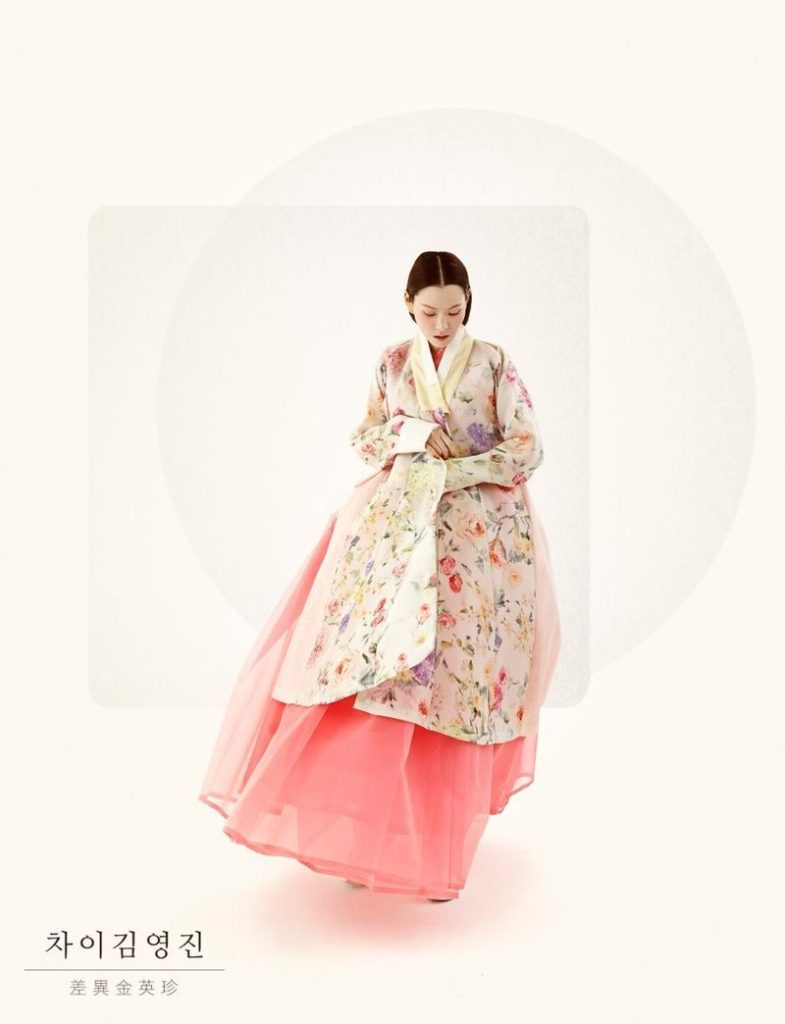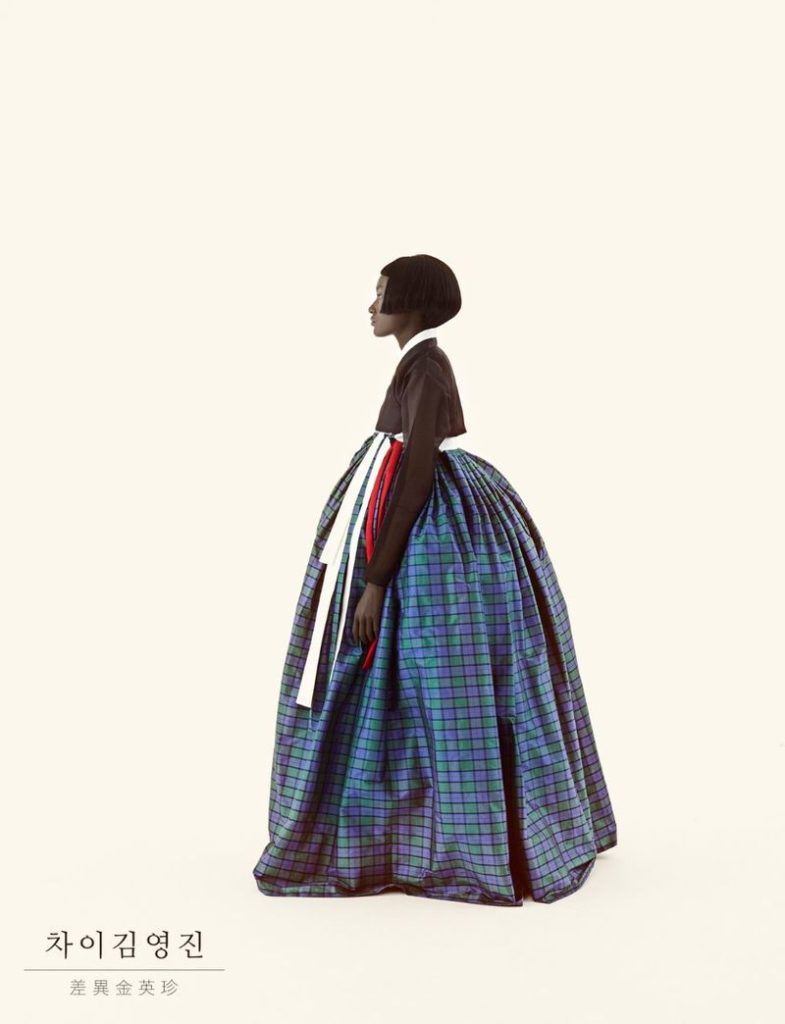우리가 열망하는 한복— 한복 디자이너 김영진
The Passion of Our Hanbok — Youngjin Kim, Hanbok Designer
우리극이 좋아 판소리, 동래학춤, 봉산탈춤을 배우고 극단에 들어간 사람, 해외 럭셔리 브랜드의 슈퍼바이저로 일한 사람, 서울시 무형문화재 11호 고(故) 박선영 침선장에게 배움을 청했던 사람, 오트 쿠튀르와 기성복의 경계를 넘나들며 옷을 만드는 사람. 얼핏 동떨어져 보이는 다양한 사람의 이야기는 ‘김영진’이라는 큰 줄기로 모입니다. 《기아 디자인 매거진》은 경계와 고정관념을 흔들며 한복에 생동을 불어넣은 한복 디자이너 김영진을 만났습니다. 한복을 동시대 패션으로 이끄는 그에게 전통이란 옛것을 고정불변하게 계승하는 일이 아닙니다. 오히려 아름다움을 향해 나아가는 생명체에 가깝죠. 김영진 디자이너는 전통과 패션에 대한 깊은 사유를 통해 동시대 한복이 살아 숨 쉬는 방법을 제시하고 있습니다.
She is someone who fell in love with Korean theater and later joined a theater company after learning pansori. The same person worked as a supervisor for an international luxury brand and implored the late Seonyoung Park, Seoul Intangible Cultural Property No. 11, to teach her traditional Korean sewing. Indeed, this is the very same woman who also creates clothes that straddle the line between haute couture and ready-to-wear garments. The stories of these seemingly disparate people all funnel together into the stream of one person—Youngjin Kim. Kia Design Magazine recently met Kim, a hanbok designer who has vitalized Korean traditional dress by shaking up boundaries and stereotypes. For Kim, who is turning hanbok into contemporary fashion, tradition is not a fixed inheritance of the past but something closer to a living creature that moves towards beauty. Through her profound thoughts on tradition and fashion, designer Youngjin Kim is showing everyone how to bring hanbok to life in today’s world.
About the Artist
김영진은 우리 시대를 대표하는 한복 디자이너다. 우리극을 하는 극단에서 배우로 활동하며 우리극 소품 만들기를 돕다가 처음 한복을 만났다. 이후 패션업계에 입성해 세계적인 럭셔리 브랜드에서 10여 년간 슈퍼바이저로 일했다. 최고급 수입 원단을 직접 바잉하던 경험은 세계에 산재한 다양한 원단에 눈뜨는 계기가 됐다. 서울시 무형문화재 11호 고(故) 박선영 침선장에게 가르침을 받으며 한복의 원형을 탄탄히 공부하고 시대별 한복을 두루 섭렵한 그는 2004년 맞춤 한복 브랜드 ‘차이 김영진’을 론칭했다. 한복의 멋을 살리면서도 현대적인 개성을 표현하는 차이 김영진은 BTS, 틸다 스윈튼, 정호연 등 국내외 다양한 유명인에게 의뢰받으며 화제를 모았다. 2013년 론칭한 기성 한복 브랜드 ‘차이킴’은 동시대성에 대한 깊은 이해를 바탕으로 패션으로서의 한복이 지닌 가능성을 표출했다. 그는 오페라 〈동백꽃 아가씨〉, 연극 〈햄릿〉, 영화 〈해어화〉, 창극 〈심청가〉 등 다양한 무대 의상을 비롯해 드라마 〈미스터 션샤인〉의 여주인공 배우 김태리의 의상을 연출하며 멈추지 않는 도전 정신을 발휘 중이다.
Youngjin Kim is one of the leading hanbok designers of her time. She first encountered hanbok while working as an actress in a troupe performing Korean theater and helping to make props. She later entered the fashion industry and worked as a global luxury brand supervisor for over a decade. The experience of purchasing the finest imported fabrics opened her eyes to the variety of worldwide materials. She studied under the late Seonyoung Park, a master of traditional sewing, and Seoul’s Intangible Cultural Property No. 11. She gained a solid understanding of the original hanbok, and learned all about hanbok from different historical periods. She ultimately launched her custom-tailored hanbok brand, Tchai Kim Young Jin, in 2004. Tchai Kim Young Jin’s hanbok, which preserves the style of the garment while expressing a contemporary personality, has been commissioned by various Korean and international celebrities, including BTS, Tilda Swinton, and Jung Ho-yeon. Launched in 2013, her ready-to-wear hanbok brand, Tchai Kim, expresses the potential of hanbok as a fashion based on a deep understanding of contemporaneity. Youngjin Kim has shown a seemingly ceaseless groundbreaking spirit in her design of myriad stage costumes for the opera La Traviata, the play Hamlet, the movie Love, Lies, and the puppet show Simcheongga, as well as costumes for the actress Kim Tae-ri, the lead actress in the drama Mr. Sunshine.
레이스 소재와 레오퍼드 패턴이 한복에 등장하고, 조선시대 남성 무관의 정복인 ‘철릭’이 현대 여성복 ‘철릭 원피스’로 변신하면서 동시대 한복에는 김영진이라는 새로운 흐름이 생겨났다. 그가 던진 신선한 제안은 우리에게 무엇인가를 묻는 듯하다. “한복은 전통인가요, 패션인가요?” 이에 답하기 위해서는 한복의 본질과 형식 사이에서 방황하는 우리 시선과 태도의 변화가 필요하다. 김영진 디자이너와 마주 앉아 한복과 전통을 둘러싼 다양한 생각과 시도를 끊임없이 공유했다. 대화를 끝낼 무렵 한 가지 사실이 분명해졌다. 사람이 옷을 입는 행위에는 언제나 아름다움에 대한 열망이 담긴다는 것이다. 한복 역시 동일한 열망을 충실히 따라왔다. 우리가 몰랐을 뿐이다. 한복이 패션으로서 사람을 열망케 하려면 무엇이 필요할까? 그와의 대화에서 촉발한 의문은 지금 한복에 대해 우리가 던져야 할 신랄하면서도 꼭 필요한 화두였다.
By drawing on the lace materials and leopard patterns that have never been a part of traditional hanbok and incorporating cheolik—an official costume of male military officers in the Joseon Dynasty—Youngjin Kim transformed this traditional garment into cheolik-style dresses for modern women and established a new trend all her own in contemporary hanbok. Kim’s fresh proposals seem to beg whether hanbok is a tradition or a fashion. To answer this, we need a change in our outlook and attitude. At the same time, we also need to wander between the essence and form of hanbok itself. After sitting down with the famed designer, we shared a wide range of thoughts concerning hanbok and tradition. By the end of our conversation, one thing became clear: the act of wearing clothes has always been about the passion for beauty. Hanbok has faithfully followed this same passion over the years; we didn’t know it in the past. The question of what it takes to have people develop a passion for hanbok as fashion—the same question sparked by our conversation—is poignant and necessary and must be asked about hanbok today.
“흔히 전통은 고정불변이라고 생각하지만, 막상 들여다보면 아니라는 사실을 절감해요. 모든 전통은 시대마다 변화를 거듭했어요. 한복도 마찬가지예요. 특히 여성 한복은 시대에 따라 저고리 길이, 소매 모양, 치마 실루엣이 계속 바뀌었죠.”
— 한복 디자이너 김영진“We often think of traditions as static, but when you take a closer look at them, you realize that’s not true. All traditions have changed over time. Hanbok is no exception, especially women’s hanbok, which has changed in terms of its jeogori length, sleeve shape, and skirt silhouette over the years.”
— Youngjin Kim, Hanbok designer
한복 디자이너로 활동한 이래 전통에 대한 의문은 김영진을 늘 따라다녔다. 전통을 해석하는 자신만의 관점이 필요하다는 절박감은 우리나라 복식사를 공들여 공부하는 이유로 충분했다. 오랜 노력을 들여 얻은 답은 의외로 단출했다. 한복은 고정불변의 대상이 아니라, 시대에 따라 바뀌는 패션이라는 사실이다. 과거의 한복은 변화를 멈춘 적이 단 한 번도 없었다. 조선시대 초기만 하더라도 기다랗던 저고리는 18세기에 가슴 싸개가 드러날 정도로 짧아졌다가 19세기부터 다시 길어졌다. 소매 또한 길고 넓게 퍼진 모양이 점차 팔 길이와 폭에 딱 맞도록 바뀌며 18세기에는 마치 입고 꿰맨 것처럼 딱 맞는 직배래가 유행했다. 그러다가 19세기부터 소매 아래가 붕어 배처럼 볼록해지면서 우리에게 익숙한 붕어배래로 바뀌었다. 치마 역시 넓게 퍼진 모양에서 치마 윗부분의 풍성함을 살리는 종 모양으로 변했다가, 18세기에는 풍성한 항아리 실루엣이 유행했다. 현재 보편적인 A 형태 치마는 고름으로 묶는 치마 대신 조끼치마가 19세기 이후 널리 퍼지면서 정착한 산물이다.
Ever since she began working as a hanbok designer, questions about tradition have always followed Youngjin Kim. The sense of urgency regarding the need to have her own perspective to interpret tradition was a major motivator for her to study the history of Korean costumes. Funny enough, the answer to her long search was surprisingly short: Hanbok is not a fixed object but a fashion that changes with the times. Over the centuries, hanbok has never stopped changing. The jeogori was a long garment in the early Joseon Dynasty, but it became shortened so much in the 18th century that it revealed a woman’s chest cover underneath the outer garment, only to be lengthened again in the 19th century. The sleeves also gradually changed from long and wide to snugly fit the length and width of the arm, with the 18th century seeing a rise in the popularity of the slim-fitting jikbaerae style that looked as if the sleeves had been sewn on after the person had donned the garment. Then, in the 19th century, the sleeves became more convex in the lower part, almost like the belly of a crucian carp, which Koreans called bungeobaerae. Long ago, skirts also went from a wide spread to a bell shape that emphasized the fullness of the upper part of the skirt, and then a fuller jar silhouette was popular in the 18th century. The now-ubiquitous A-shaped skirt is a product of the 19th century when vest-type skirts became more prevalent in place of string-tied skirts.



“전통이든, 패션이든, 한복의 본질은 멋과 아름다움이라고 생각해요. 아름다움이야말로 패션의 포인트잖아요. ‘이렇게 입어야 전통이야’라는 말에 갇혀서 정작 본질적인 아름다움을 보지 못하는 상황은 최대한 지양했어요.”
— 한복 디자이너 김영진“I think the essence of hanbok, whether it’s tradition or fashion, is style and beauty. Beauty, and nothing else, is the point of fashion. I’ve tried hard to avoid any situation in which we are stuck with the description ‘This is tradition’ as opposed to ‘Seeing the essential beauty.’”
— Youngjin Kim, Hanbok designer
스스로 한복의 미(美)에 대해 결론 내리기까지 그는 한복을 시대별로 직접 만들어 입어 보았다. 그 과정에서 18세기 후반 한복의 실루엣이 지금 우리가 추구하는 아름다움과 가장 맞닿아 있다는 확신이 들었다. 조선 후기를 대표하는 풍속화가 신윤복이 그린 〈미인도〉 속 여인의 옷차림을 보면 치마는 풍성하고, 상의는 꼭 맞는 형태다. 18세기 후반 여성복의 전형적인 형태인 ‘하후상박’인데, 이런 특색을 모티브 삼아 론칭한 맞춤 한복 브랜드가 ‘차이 김영진’이다.
Until she came up with her own conclusion about the beauty of hanbok, Youngjin Kim made and subsequently tried on hanbok from different eras. During the process, she became convinced that the silhouette of late 18th-century hanbok most closely resembles the beauty we seek today. As can be seen by the attire of the woman in A Beautiful Woman, a painting from the notable late Joseon Dynasty folk painter Shin Yun-bok, the skirt is full, and the top fits snugly. This is the sangbakhahu (literally: top light, bottom heavy) style, a typical form of women’s clothing in the late 18th century. Tchai Kim Young Jin is a custom-tailored hanbok brand that was launched based on this motif.


그러나 사람들은 19세기 후반에 나타난 붕어배래가 전통 한복의 선을 대표한다는 고정관념을 가지고 있었다. 그의 한복을 두고 전통에서 벗어났다는 갑론을박이 오간 이유다. 하지만 시기적으로 따지자면 직배래를 적용한 ‘차이 김영진’의 한복이 시중의 붕어배래보다 더 오래된 전통을 따른다. 그렇지만 그는 무엇이 더 전통에 가까운지 논리적으로 항변하지 않았다. 오히려 자신을 찾아온 손님에게 직배래와 붕어배래 모두를 만들어 주고, 그중 더 예쁜 것을 입으라며 선택권을 넘겼다. 사람들은 자연스럽게 직배래를 선택했다. 그의 안목과 자신감의 승리였다. 한복의 실루엣이 끊임없이 바뀌는 와중에도 오직 변치 않고 추구한 것은 다름 아닌 아름다움이었다. 김영진은 한복 또한 패션에 속한다는 당연한 사실을 상기시키며 결국 전통 또한 아름다움을 열망해 왔다는 점을 강조한다. 이처럼 전통의 본질을 자신만의 시각으로 파악하고 디자인에 적용한 그는 대중의 관념에 깔리지 않고 남다른 제안과 시도를 지속했다.
Until recently, however, many people stereotypically believed that the bungeobaerae, which first appeared in the late 19th century, is the best form of the traditional hanbok, which is why there were pros and cons about Kim deviating from tradition with her own hanbok collection. Thus, in terms of time period, Tchai Kim Young Jin’s hanbok, which features the jikbaerae style, follows an older tradition rather than the bungeobaerae hanbok currently being sold by many hanbok designers. Kim never tried to force her opinion on others as to which style is more traditional. Instead, she made both the jikbaerae and bungeobaerae styles for her customers, giving them the choice to wear whichever one they thought was more beautiful. Customers naturally chose the jikbaerae style. It was a triumph for Kim and her discernment, not to mention for her confidence. While the silhouettes of hanbok have constantly changed, the only thing that people have ceaselessly been pursuing is beauty. Kim reminds us of the obvious fact that hanbok belongs to fashion, and emphasizes that tradition has always aspired to beauty. By grasping the essence of tradition from her own perspective and applying it to her designs, she has continued to blaze her own trail without being overly swayed by popular opinion.
“한복이라는 단어에 갇혀서 새로운 시도를 하지 않는 건 제 방식이 아니에요. 만일 우리나라가 일제강점기를 겪지 않고 독자적으로 서양 문물을 받아들였다면, 우리 복식은 어떻게 전개됐을까요? 기성 한복 브랜드 ‘차이킴’은 이런 질문에서 시작됐어요.”
— 한복 디자이너 김영진“Becoming mired in simply thinking of the word hanbok and not trying anything new is not who I am as a designer. If Korea hadn’t gone through the Japanese occupation and embraced Western culture on its own, how would our clothing have developed? The ready-to-wear hanbok brand Tchai Kim was born out of this question.”
— Youngjin Kim, Hanbok designer
고정관념이 사라진 빈자리는 무엇으로 채워야 할까? 김영진은 자신의 상상을 눌러 담아 기성 한복 브랜드 ‘차이킴’을 론칭한다. 맞춤복은 특정 인물에 맞춰 모든 부분을 온전히 집중해야만 한다. 반면, 기성복은 디자이너의 창의력과 감성이 중요한 역할을 한다. 상상력에 대한 갈증에서 시작한 만큼, 차이킴에는 재미있는 발상을 담은 옷이 가득하다. 그 밑바탕에는 세계 각국의 복식을 꾸준히 공부하며 우리에게 걸맞은 요소를 발견하고 한복에 접목하려는 노력이 존재한다. 프랑스 낭만주의 시대의 복식에서 보이는 문양이 동양의 것과 닮았다는 점에 근거해 서양 복식에서 찾을 수 있는 한복다운 요소를 끌어와 차이킴 의상에 적용하는 식이다. 차이킴이 추구하는 한복은 더 이상 계승해야만 하는 유물이 아니라, 동시대 사람의 멋을 표현하는 패션으로서 새로운 역할을 맡는다. 차이킴의 수많은 의상 중 철릭 원피스는 특히 주목할 만하다.
How should we fill the void left by stereotypes? — Youngjin Kim’s answer was to launch Tchai Kim, a ready-to-wear hanbok brand that embodies her imagination. Custom-made clothes require a complete focus on a specific person. On the other hand, the designer’s creativity and sensibility play a significant role in creating ready-to-wear garments. Since Tchai Kim was born from a thirst for imagination, the brand is full of clothes abounding with exciting ideas. And underneath it all, Youngjin Kim continues to study dresses from all over the world as she attempts to find the best elements she can incorporate into hanbok. For example, based on the similarity of patterns found in French Romantic-era clothing and specific garments from the East, Kim draws on hanbok elements found in Western clothing and applies those elements to Tchai Kim’s garments. For Tchai Kim, hanbok is no longer an artifact to be passed down through the generations but something that takes on a new role as fashion that expresses the styles of contemporary people. Among Tchai Kim’s many clothing items, the cheolik dress is particularly noteworthy.
“조선시대 남성 복식을 살펴보면 생각보다 훨씬 패셔너블하고 다채로워요. 남성 중심의 관료 사회라는 시대상이 의복에도 반영됐던 거죠. 당시 발달했던 남성 복식의 특성에 착안해 옷을 만들어 보기로 했어요. 여러 실험 끝에 조선시대 무관의 정복이었던 철릭이 현대 여성을 위한 철릭 원피스로 다시 태어났습니다.”
— 한복 디자이너 김영진“If you look at men’s clothes in the Joseon Dynasty, they were much more fashionable and varied than you might think. The male-dominated bureaucratic society of the era was reflected in the clothing. We decided to make clothes based on the characteristics of men’s clothes developed at that time. After much experimentation, cheolik, an official costume of Joseon Dynasty military officers, was reborn as a cheolik dress for the women of today.”
— Youngjin Kim, Hanbok designer
서울시 무형문화재 11호 고(故) 박선영 침선장에게 한복을 배우던 시절, 김영진은 조선시대 무관이 입던 공복인 ‘요선철릭’을 만난다. 허리선을 따라 촘촘하게 주름을 잡은 요선철릭을 보며 그는 자연스럽게 여성이 입는 원피스를 떠올렸다. 기성 한복 브랜드 차이킴을 시작하며 현재와 과거, 전통과 외래, 동양과 서양, 여성과 남성 등 대비되는 특성을 활용해 전에 없던 새로운 산물을 제시하는 데 집중한 그의 손을 거쳐 요선철릭은 여성을 위한 원피스로 변신했고, 이제 철릭 원피스는 디자이너 김영진을 상징하는 아이템이 되었다.
While studying hanbok from the late Seonyoung Park, Seoul’s Intangible Cultural Property No. 11, Youngjin Kim came across yoseoncheolik, an official costume worn by military officers during the Joseon Dynasty. Looking at the tightly pleated yoseoncheolik along the waistline, she naturally thought of a dress worn by women. After starting a ready-to-wear hanbok brand called Tchai Kim, she focused on utilizing the contrasting qualities of the present and past, traditional and foreign, East and West, and female and male to come up with new and unprecedented garments. Through her gifted hands, yoseoncheolik was transformed into a dress for women, and now the cheolik dress has become a signature item from designer Youngjin Kim.


철릭 원피스를 디자인할 때 그는 전통 복식을 현대 의복으로 풀어내는 방법에 대해 깊이 고민했다. 보통 동양적인 복식을 세련되게 풀어낼 때는 서양 특유의 입체 재단을 맞바로 도입하는 경우가 흔했다. 김영진은 이런 접근이 너무 쉽고 뻔하다고 생각했다. ‘최대한 동양 특유의 평면 재단에 가깝게 디자인해 한복의 멋을 살리면서 예쁘고 편안하게 만들 수 없을까?’ 고민 끝에 가운데 부분에 평면 재단과 입체 재단을 함께 사용하면서 현대 여성복 트렌드에 맞춰 어깨를 좁히고 허리를 강조한 철릭 오피스가 탄생했다. 단순히 전통을 형식으로 바라보지 않고 전통이 추구하는 아름다움을 놓지 않는 노력이 이룬 성과다.
When initially designing the cheolik dress, Kim put a lot of thought into how to translate traditional clothing into contemporary garments. When it comes to sophisticated Eastern clothing, it is usually most common to adopt the three-dimensional cutting method of the West. Youngjin Kim thought this approach could have been more straightforward and obvious. As she once put it, “I wondered if I could design hanbok as close as possible to the flat cutting style unique to East Asia and make it beautiful and comfortable while keeping the style of traditional hanbok alive.” After a great deal of thought, she came up with the cheolik dress, which uses a combination of flat and three-dimensional cutting in the center, narrowing the shoulders and emphasizing the waist, and in line with modern womenswear trends. This results from efforts not to look at tradition as a simple form but to hold on to the beauty that traditional fashion has pursued.



“태국 전통 의상에 쓰이는 타프타 실크는 실내조명에서 영롱한 빛을 발해요. 우리나라 전통 소재는 야외에서 굉장히 아름답죠. 야외에서 모든 예식을 올리는 시대는 지났고, 요즘은 실내에서 대부분의 예식을 진행합니다. 그래서 치마는 타프타 실크, 저고리는 우리나라 전통 소재를 사용하는 ‘믹스앤매치mix and match’를 통해 아름다움을 조화롭게 가져가려고 노력해요.”
— 한복 디자이너 김영진“Taffeta silk, which is used in traditional Thai costumes, shines brilliantly in interior lighting, and traditional Korean materials look stunning outdoors. Gone are the days when all wedding ceremonies were held outdoors, as nowadays most ceremonies are held indoors. Thus, we try to harmonize beauty by mixing and matching, using taffeta silk for the skirt and traditional Korean materials for the jeogori.”
— Youngjin Kim, Hanbok designer
원단부터 다르다. 김영진의 한복에 보내는 세간의 평가다. 단순히 고품질을 사용한다는 의미가 아니다. 이전과는 ‘다른’ 원단으로 한복을 만든다. 한복에 잘 쓰이지 않던 울, 니트, 레이스를 과감히 사용하고, 레오퍼드, 체크 같은 강렬한 프린트를 적용하는 일에도 망설임이 없다. 독창적인 믹스앤매치는 낯설지만 어색하지 않다. 조화롭게 어울려 사람들의 눈길을 더욱 사로잡는 요인이다. 럭셔리 패션 브랜드의 대명사인 루이 비통에서 원단을 바잉하며 고급 원단의 중요성을 체감한 그는 탐나는 원단이 있다는 소문이 들리면 어디든 찾아간다. 브랜드의 감성을 살리는 원단을 위해 이탈리아, 프랑스, 태국 등 실크로 유명한 현지에 들러 원단을 꼼꼼히 살핀다. 이탈리아 최고급 실크 산지인 꼬모에서 한복을 위한 원단을 구매한 일화는 그녀의 믹스앤매치 감각을 짐작케 한다. 브랜드 한 곳에서 30가지가 넘는 원단을 골랐는데, 알고 보니 모두 동일한 디자이너가 참여했던 것. 브랜드 담당자도 놀란 해프닝은 자신이 만드는 한복, 전통, 디자인에 대한 치밀한 안목이 존재하기에 가능한 일이었다. 확고한 믿음과 철학을 가지고 있기에 한복의 범주에 새로운 소재와 프린트를 들이는 일에 두려움 없이 임할 수 있었다. 이런 변주는 한복과 동시대 간에 드리워진 시차를 거침없이 지워버린다.
First of all, the fabric is different. This is what people generally say about Youngjin Kim’s hanbok. It does not just mean that she uses high-quality fabrics; compared to those before her, she uses different fabrics to make hanbok. She boldly uses wool, knit, and lace, none of which were commonly used in hanbok in the past, and does not hesitate to apply powerful pattern prints, such as leopard and check. Her creative mix-and-match style may be unfamiliar, but it is not awkward. The harmonious combination makes it more eye-catching. With respect to the fabrics she uses, Kim learned the importance of quality fabrics when she was a fabric buyer at Louis Vuitton—a brand synonymous with luxury fashion. Today, she goes wherever she has to find the most coveted fabrics. To find fabrics that fit her brand’s sensibility, Kim often travels to Italy, France, Thailand, and other countries are known for their silk, checking all her fabrics with a meticulous eye. One example of her successful mix-and-match sense was when she bought fabrics for hanbok from Como, Italy’s finest silk-producing area. At that time, she picked out over 30 different fabrics from one brand, and it turned out that one designer participated in designing all those fabric products. This also surprised the Italian brand manager, and that was only because she has a keen eye for hanbok, tradition, and design. With strong beliefs and a deeply rooted philosophy, Kim was not afraid to introduce new materials and prints into the category of hanbok. These material variations effortlessly erase the time gap between hanbok and the contemporary era.


“사람이 옷을 입는 이유는 무엇일까요? 더위와 추위를 막기 위한 기능적인 이유도 있지만, 그 본질은 아름다움에 있다고 생각해요. 옷은 사람과 아름다움을 이어주니까요.”
— 한복 디자이너 김영진“Why do people wear clothes? There are functional reasons—to keep out the heat and cold—but I think the essence is about beauty, as clothes connect people with beauty.”
— Youngjin Kim, Hanbok designer
김영진은 말한다. 패션의 본질은 아름다움에 있다고. 한복 또한 아름다움을 추구했기 때문에 이제는 전통을 확장하며 형식이 아니라 본질에 해당하는 미(美)에 초점을 맞춰야 한다고 믿는다. 옛 남성의 의관을 현대 여성복으로 풀어내고, 해외 고급 원단을 한복에 자유롭게 접목하는 김영진의 시도를 통해, 우리는 한복이 편견에서 벗어나 전통의 핵심을 꿰뚫을 때 얼마나 자유롭고 아름다울 수 있는지 알아챈다. ‘고정관념을 벗고 본질을 입은’ 한복을 통해서.
K컬처가 전 세계 대중문화에 영향을 미치는 지금, 한복은 동시대적 전통에 근간을 둔 세계적인 패션으로 성장할지, 아니면 고리타분한 관념에 갇혀 존재감이 희미해질지 그 갈림길에 서 있다. 사람들이 K컬처를 열망하는 이유는 K라는 라벨 때문이 아니라, 열망의 마음을 숨기지 못할 만큼 K컬처가 고유의 매력을 가지고 있기 때문이다. 한복도 마찬가지다. 정말 사람들이 열망할 만한 예를 제시해야 K컬처의 줄기로서 무한한 가능성을 펼칠 수 있다. 이 새로운 기로에서 우리가 고민할 거리는 그리 대단하지 않다. 본질을 잊지 않고 동시대의 전통에 주목하는 일이면 족하다. 한복 디자이너 김영진이 18세기도, 19세기도 아닌 바로 지금 21세기의 전통으로 아름다움을 축조하는 것처럼.
Youngjin Kim says that the essence of fashion is beauty. Since hanbok has always been about pursuing beauty, she believes that we should expand the tradition and focus on beauty—the essence of fashion—not the form. Through Youngjin Kim’s attempts to translate what was historically seen as men’s garments into modern women’s wear while also incorporating high-end fabrics from overseas into hanbok, we see how freeing and beautiful hanbok can be when it is absent of prejudice and allowed to penetrate the heart of tradition.
With K-culture influencing popular culture worldwide, hanbok is at a crossroads; it will either grow into a global fashion rooted in contemporary traditions or fade into obscurity, trapped in a staid notion of what hanbok must always remain. People grow passionate about K-culture not because of the “K” label itself but because K-culture has its unique charm for which these same people cannot hide their passion. The same goes for hanbok. We need to provide an example that people can genuinely aspire to so that hanbok can unfold infinite possibilities as a branch of K-culture. At this new intersection for hanbok, we need not worry, as it is sufficient to heed contemporary traditions without forgetting the essence—just as hanbok designer Youngjin Kim is doing by creating beauty not modeled after the 18th or 19th centuries, but in the tradition of the here and now of the 21st century.